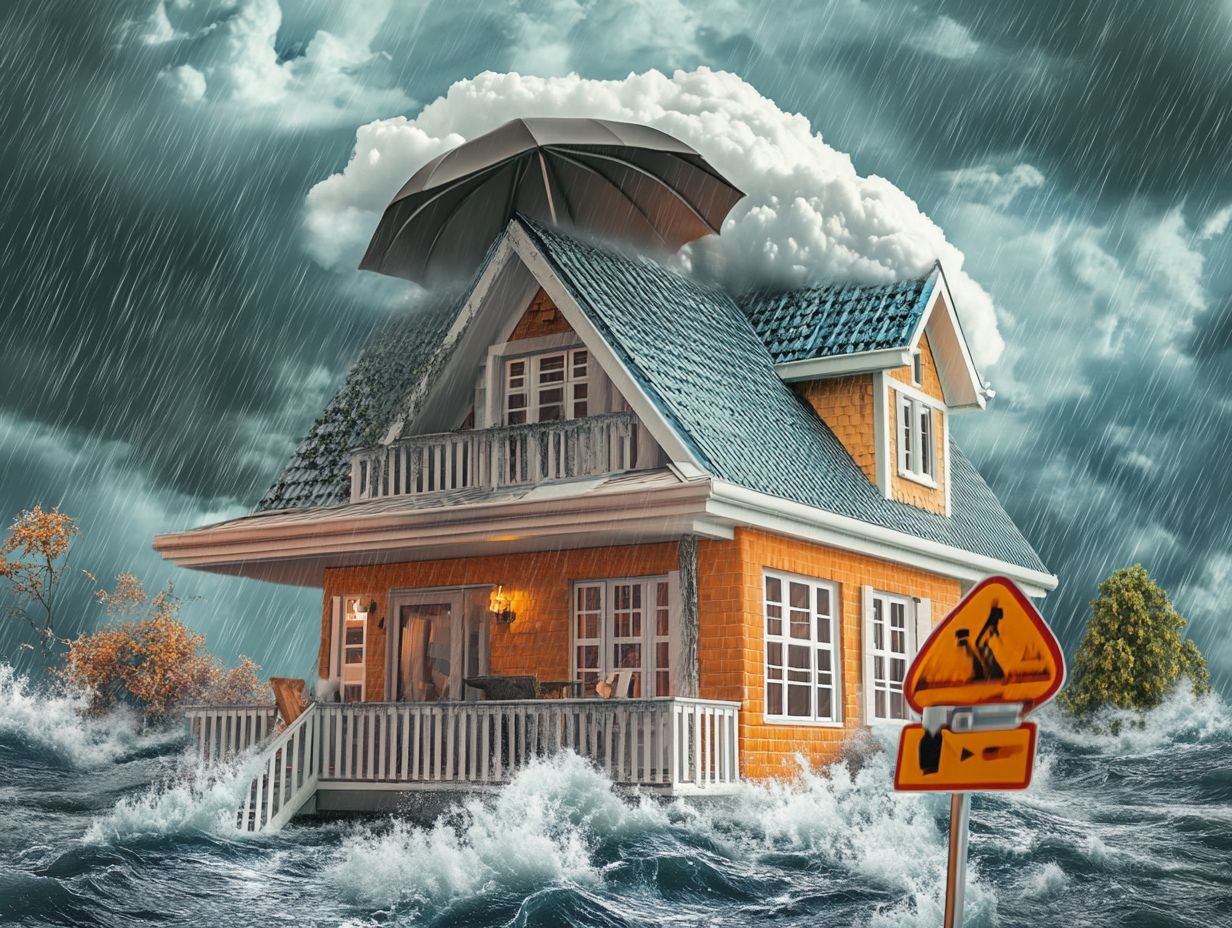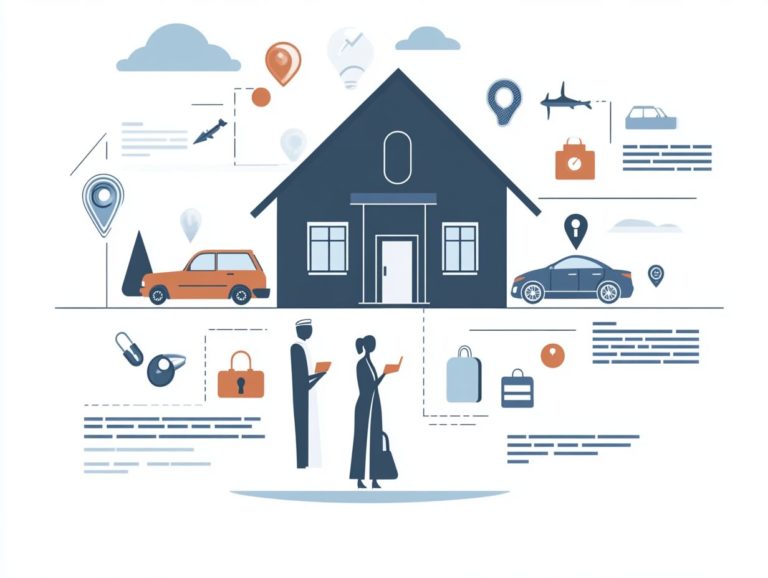What is Home Insurance for High-Risk Areas?
Protecting your home means understanding high-risk areas. These locations are vulnerable to natural disasters like floods, earthquakes, and wildfires.
This guide will help you understand high-risk areas. It emphasizes the importance of home insurance in reducing potential losses.
We ll also explore the different types of coverage available. Learn how to lower your premiums without losing essential protection.
Whether you own a home or are considering buying in a high-risk zone, this information empowers you to make informed decisions.
Contents
- Key Takeaways:
- Understanding High-Risk Areas
- Why Home Insurance is Important for High-Risk Areas
- Types of Coverage for High-Risk Areas
- Factors Affecting Home Insurance Rates in High-Risk Areas
- How to Lower Home Insurance Costs in High-Risk Areas
- Frequently Asked Questions
- What is Home Insurance for High-Risk Areas?
- What are High-Risk Areas for Home Insurance?
- What Coverage Does Home Insurance for High-Risk Areas Usually Include?
- How is the Cost of Home Insurance for High-Risk Areas Different?
- How Can I Lower the Cost of Home Insurance for High-Risk Areas?
- Do I Need Separate Insurance for Different Natural Disasters?
Key Takeaways:

Home insurance protects properties in high-risk areas from damages caused by natural disasters.
Factors like location and home features greatly impact insurance rates.
Homeowners can reduce costs by taking precautions and comparing insurance providers.
Understanding High-Risk Areas
Understanding high-risk areas is essential for homeowners seeking adequate insurance. Properties in disaster-prone regions face unique challenges.
Geographical factors play a significant role in how insurance companies define high-risk areas. These factors directly influence the coverage options available to you.
Insurance companies consider potential additional premiums and policy limitations. You need to navigate these to secure comprehensive coverage.
Defining High-Risk Areas for Home Insurance
High-risk areas are defined by several factors, with property location being the most critical. This helps assess vulnerability to natural disasters or crime.
Historical claims data is essential. It provides insight into past incidents, helping insurers estimate future claims and adjust premiums.
Environmental factors, like proximity to flood zones, significantly affect coverage requirements. Insurers evaluate these elements during the underwriting process.
Ultimately, high-risk designations may limit your options or increase costs. Your challenge is to secure adequate protection for your assets.
Why Home Insurance is Important for High-Risk Areas
Home insurance is vital if you live in high-risk areas. It protects against natural disasters that can lead to significant financial losses.
This is especially important for homes affected by location, age, or environmental hazards. Insurance helps manage risks and allows you to recover from potential damages.
Potential Risks and Costs
Living in high-risk areas means costs can rise due to the likelihood of natural disasters. This impacts your insurance premiums significantly.
Structural issues, such as aging roofs or outdated systems, complicate these risks. They can contribute to a higher claims history, affecting your insurer’s financial stability.
As a result, insurers may raise premiums or set stricter coverage requirements. If you live in a flood or wildfire-prone area, consider specific policies tailored to these risks.
Understanding these factors is essential for protecting your investments in vulnerable environments.
Types of Coverage for High-Risk Areas

In high-risk areas, it s crucial to understand the different types of homeowners coverage available to protect your property from disasters.
This includes specialized insurance options like flood, earthquake, and wildfire coverage, each tailored to address specific risks in your area.
Knowing your coverage options helps you protect your home from the unexpected!
Flood Insurance
Flood insurance is essential for homeowners in high-risk areas, providing important financial protection against water damage that standard policies typically miss.
This coverage fills a significant gap, especially since most homeowners insurance excludes flood-related losses.
If you live near coastlines or rivers, you face unique challenges that make this coverage critical.
Several factors affect flood insurance pricing, including your home’s elevation, location, and the flood history in your area.
With climate change raising awareness about severe weather, the importance of comprehensive flood coverage has never been clearer.
During heavy rainfall or storm surges, relying solely on standard insurance poses a considerable risk.
This underscores the need to invest in flood insurance to protect your financial future.
Earthquake Insurance
Earthquake insurance is vital for homeowners, especially if you live in areas prone to earthquakes.
This insurance covers structural damage, personal property loss, and additional living expenses during repairs.
Without this coverage, you risk devastating consequences after a major earthquake.
Keep in mind this coverage often acts as an endorsement to your existing homeowners policy, especially in high-risk zones where standard coverage has limits.
When a quake strikes, document any damage promptly to initiate your claim.
Insurance adjusters will assess the losses to determine the compensation you deserve.
Understanding these components can significantly impact your financial recovery after seismic events.
Wildfire Insurance
Wildfire insurance is crucial for homeowners in disaster-prone areas, offering protection for properties vulnerable to fire damage.
In high-risk zones, potential policyholders should understand how factors like proximity to forests and fire mitigation measures can affect coverage availability and premiums.
Insurance companies evaluate the likelihood of wildfires using data from local fire departments and historical damage reports.
Consider engaging with multiple providers to find the best terms, ensuring you have adequate protection against the financial consequences of wildfires.
By addressing these factors, you can better safeguard your home from unpredictable disasters.
Factors Affecting Home Insurance Rates in High-Risk Areas
Several factors determine home insurance rates for high-risk homeowners, including property condition, location, and your credit score.
Understanding these elements is vital for securing accurate home insurance quotes and managing your premiums.
By being aware of these influences, you can make informed decisions and potentially save on your coverage.
Location and Risk Assessment

Location is crucial when assessing risk for high-risk homeowners. Insurance providers often take location factors into account to determine the potential hazards associated with a property. This ultimately shapes unique coverage options and premium costs.
If your property is in a flood-prone area or a region at risk of wildfires, you may face significantly higher premiums. Insurers calculate the likelihood of claims related to these specific risks, leading to those elevated costs.
If you’re in an urban area, expect greater liability concerns. Providers will likely scrutinize the safety measures you have in place. They may also evaluate local crime rates, the lay of the land, and how close you are to emergency services during their assessments.
As a high-risk homeowner, you need to navigate this intricate insurance landscape and invest in risk mitigation strategies. Doing so can help you optimize your coverage options and potentially lower your costs.
Home Features and Safety Precautions
The features of your home, along with the safety measures you implement, can greatly influence your insurance premiums and claims history. These are vital considerations, especially in high-risk areas.
For example, homes with sturdy structural features, like reinforced roofs and solid foundations, present a lower risk to insurance providers. By installing safety equipment such as smoke detectors, security systems, and fire extinguishers, you enhance your safety and showcase a proactive approach to risk management.
These elements can lead to fewer claims over time, often resulting in lower annual premiums. A well-maintained property that complies with local building codes is less likely to encounter accidents, reinforcing your reputation with insurance companies.
Investing in these features protects you and effectively manages your financial obligations related to insurance.
How to Lower Home Insurance Costs in High-Risk Areas
To lower home insurance costs in high-risk areas, you need a strategic approach that involves thorough risk assessment, diligent home maintenance, and proactive mitigation measures.
By taking these steps, you can unlock significant insurance discounts and secure more favorable policy pricing, benefiting your financial well-being as a homeowner.
Mitigating Risks and Making Home Improvements
Mitigating risks through targeted home improvements and safety measures is an effective strategy to lower your insurance premiums while enhancing the protection of your property against potential disasters.
By investing in fire-resistant materials such as choosing stucco or stone exteriors over wood you can significantly reduce the likelihood of devastating fire damage.
Implementing flood barriers, or structures that keep water from entering your home, offers essential protection for homes in flood-prone areas, serving as a crucial defense against rising waters.
These proactive measures enhance your safety and can lead to lower premiums on your homeowners insurance. Insurers often reward individuals for taking substantial steps to minimize risks.
Ultimately, embracing these improvements creates a safer living environment while alleviating the financial burden of insurance costs.
Comparing Insurance Providers
Comparing insurance providers is crucial for homeowners in high-risk areas. Different companies present a range of home insurance quotes, coverage options, and customer service experiences that can significantly influence the claims process and your overall satisfaction.
By carefully evaluating these providers, you can reveal essential differences not only in premiums but also in the coverage available for natural disasters, theft, or liability claims.
Assessing the financial strength of insurers is vital; it gives you insight into their ability to pay out claims when you need it most. Customer service is equally important; finding a provider that offers accessible support and efficient claims handling can truly make a difference during stressful times.
To make an informed decision, gather multiple quotes, read reviews, and ask questions about policy specifics. This way, you ensure that your final selection aligns perfectly with your unique protection needs.
Frequently Asked Questions

What is Home Insurance for High-Risk Areas?
Home insurance for high-risk areas protects properties in regions vulnerable to natural disasters. If you’re wondering what home insurance covers, it’s important to consider areas prone to earthquakes, hurricanes, wildfires, and floods.
What are High-Risk Areas for Home Insurance?
High-risk areas are locations likely to experience natural disasters. Examples include coastal regions susceptible to hurricanes and areas near fault lines.
What Coverage Does Home Insurance for High-Risk Areas Usually Include?
This type of insurance generally covers damage to the home structure and personal belongings. It also offers liability protection if someone gets injured on your property.
How is the Cost of Home Insurance for High-Risk Areas Different?
Home insurance for high-risk areas usually costs more than standard policies. Prices vary based on location and the coverage level you choose.
How Can I Lower the Cost of Home Insurance for High-Risk Areas?
You can reduce costs by installing protective features, like storm shutters, or reinforcing your home. Bundling policies and keeping a good credit score also help.
Do I Need Separate Insurance for Different Natural Disasters?
It depends on your insurance provider. Some policies cover multiple natural disasters, while others may require separate coverage for each type.






